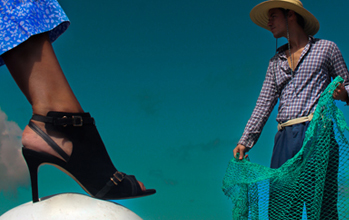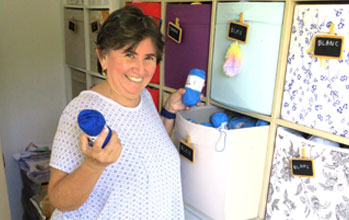
A familiar face on St Barts, Birdy of IslanDiving has a natural passion for the underwater world. He spoke with energy and enthusiasm while offering Coccoloba readers an insight into his life on St Barts.
 How is IslanDiving different to other diving enterprises?
How is IslanDiving different to other diving enterprises?
I have worked as a professional diver in St Barts since 1993. I therefore have a solid foundation of experience and sound knowledge of the protected sites within the marine park where there is a good concentration of sea life. Furthermore, my boat was specifically built as a dive boat, including a canopy to shield divers from the sun. This means they don’t need to use sunscreen, which is harmful to coral.
What was the inspiration for IslanDiving?
My parents gave me an aquarium when I was just 4 years old, which instigated my love of sea life. I learned to swim at a very young age and preferred to swim under water, particularly as I could hold my breath for a long time. I believe that diving is like nothing else on Earth. Watching underwater life brings peace of mind; it is a unique experience to be shared with others.
 How did you decide to live and work on St Barts?
How did you decide to live and work on St Barts?
I first encountered the Caribbean during two transatlantic crossings on a sailboat, which inspired me to move to St Barts in 1993. At that time, Jacques Cousteau was considered to be the master of the diving world. Nevertheless, I chose to do shallow PADI diving, which is much safer than the French style of diving in deep water. Fish need light and need to be close to the surface and food. You can thus see an abundance of sea life at 15 metres or less. Coral reefs are the centre of the sea’s biodiversity, so there is no need to dive in deep water.
 I visited many other islands of the Caribbean but chose St Barts for its exclusive easily accessible dive sites protected by the marine park. The warm temperature of its waters only require a rash guard in the summer and short wetsuit in the winter, allowing divers to feel the massaging sensation of the water. In addition, I was attracted by the island’s beautiful beaches, its quality restaurants and good food, together with its great ambiance.
I visited many other islands of the Caribbean but chose St Barts for its exclusive easily accessible dive sites protected by the marine park. The warm temperature of its waters only require a rash guard in the summer and short wetsuit in the winter, allowing divers to feel the massaging sensation of the water. In addition, I was attracted by the island’s beautiful beaches, its quality restaurants and good food, together with its great ambiance.
 Who are your principal clients?
Who are your principal clients?
I have a very wide range of recreational divers, from 7 to 77 year olds, and from local islanders to VIP visitors. I welcome everyone, regardless of their background or ability.
What outstanding features are there to see in St Barts’ waters?
There are approximately thirty good dive sites within the marine park around St Barts. These waters are inhabited by many interesting species, including spotted eagle rays, sting rays, turtles, sharks and huge lobsters. The fish in the marine park are not used to predators so they are more visible to divers compared with those in other areas.
 What is the condition of the dive sites off St Barts; does their protection allow them to survive and flourish? Are you involved in any local protection projects?
What is the condition of the dive sites off St Barts; does their protection allow them to survive and flourish? Are you involved in any local protection projects?
The St Barts dive sites are in a very good condition because they are regulated by the marine park. However, man has placed the world’s sea life in danger through overfishing and pollution. Without sea species humanity will suffer, not only through lack of fish for food but through a reduced supply of oxygen. We have a responsibility for the future of the planet.
In 1995, I instigated the cleaning of St Barts’ dive sites. Thankfully, the island now has an incinerator to burn our waste versus throwing it in the sea, a common practice on other islands. St Barts is ahead of its time in how it treats its refuse, which helps to keep the marine park litter-free.
Furthermore, IslanDiving was the first to assist Didier Laplace with his coral protection and regeneration projects. This work has helped to raise awareness, which is important for the future of St Barts’ waters.
 Does IslanDiving have a mission?
Does IslanDiving have a mission?
I want to share my passion by introducing people to the underwater world, even those who lack confidence. I use a special approach for hesitant divers known as ‘snorkelling deluxe®’. I slowly encourage these divers, allowing them to witness the beauty of the ocean and realise that it is a safe place if basic rules are followed.
 Where does the name Birdy come from?
Where does the name Birdy come from?
A client started calling me Birdy instead of Bertrand. I instantly liked the name, particularly because swimming underwater is akin to flying!
What message would you like to convey to the readers of Coccoloba?
I would like everyone to be aware of the need to protect the oceans for future generations to come. To quote the conservation and environmental activist,
Captain Paul Watson, ‘If life in the seas dies and if the ocean dies, we die.’



